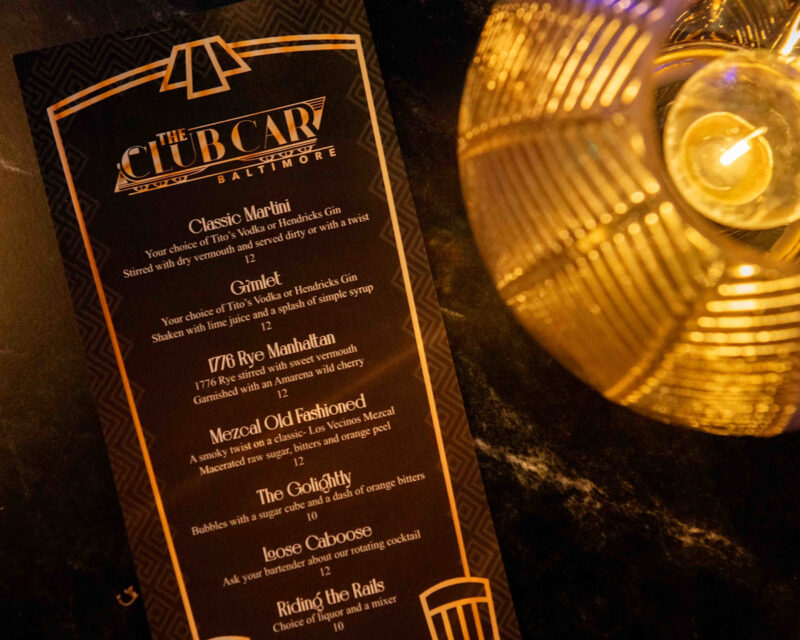“Can I give you something good?” Damye Devine Hahn appears with a fresh-caught fish fillet, broiled a moment earlier, on a paper plate with three lemon wedges. Damye’s eyes are gleeful as her mother, Nancy Faidley Devine, tries the midday treat. Nancy has a matriarch’s perch, positioned on a tall stool over the chest-high cashier’s counter. The 28-pound Maryland rockfish is fresh seafood at its best—tangy, buttery, and simply delicious.
Artifacts from the Faidley’s Seafood’s 133-year history at Lexington Market cover the walls and counters that make up the fresh fish ice boards, the cooked food corner, and the raw bar at the center of the room. “We’re like the face of old Baltimore,” Damye chuckles. “We really are like a museum.” Damye and Nancy’s rapport slides and overlaps, creating the conversational music that close families often share. Hearing their jib, one can imagine that the same rhythms have filled this space for a long time, coming from the mouths of their ancestors.
Lexington Market has been a part of the Faidley family identity for generations. For Damye, Nancy’s eldest daughter, being in the family business was never a question. “My children were very close to their grandfather and their great-grandfather. Even when they were little toddlers they were a part of it.” William “Bill” Devine, who married Nancy and resigned his Navy post in 1964 to become a part of the family fish business, runs the books from an office above the market. Bill and Nancy, 87 and 83 years old respectively, guide Faidley’s day-to-day operations. “We got old in here,” Nancy chuckles, looking out over her domain.

Faidley’s Seafood opened in 1886 in the original Lexington Market building, operated by Nancy’s grandfather, John W. Faidley, Sr. The fish stand was a staple for fresh seafood and wild game like duck, raccoon, and muskrat. They were famous for their turtles, out of which people made then-fashionable terrapin stew. In 1949, Lexington Market burned down, leaving the Faidleys to fend for themselves for three years as the replacement building emerged. Nancy’s father, John W. Faidley, Jr. had to get another job, and her mother Albina Faidley sold fish in the parking lot next to the construction site, season after season.
The new building, unveiled in 1952, was a fresh start. Clad in her high school uniform, Nancy fashioned after school fish sandwiches, jumpstarting the Faidley’s cooked foods section. And now, the Faidley family is readying for another era of renovation and redevelopment.
Seawall Development, known for various development in Baltimore including the high-end food court R House, was selected by Lexington Market Industries for a 2020 redevelopment of the oldest market in America.
The market’s vendors and patrons find themselves in a suspenseful mix of hope and fear. Staff members are looking forward to new bathrooms and a roomier kitchen, and while the vendors could certainly use updated facilities and financial opportunities, Lexington Market’s character and accessibility are also at risk.
“It’s going to be hard,” Nancy notes, gesturing to the decorated walls, “to mix the new with the old and have it jell.”

The market stands out for its legacy of serving people of all races and classes. “One of the great things about Lexington Market is that it was an everyman’s market,” Damye says. “Somebody who only had a couple of bucks could come in and get something. Somebody who had a lot of bucks could come get something different.”
Lexington Market also accepts state food assistance programs, but new regulations have led to a crackdown for vendors selling prepared foods or a single food group, like seafood. In a market offering fresh food, this well-intentioned regulation is harmful in a city known for its food deserts. Damye feels passionately about people’s right to good food, like the elders who come to Faidley’s to get seafood instead of going to the 7-Eleven. “People are like, ‘I can’t believe you take EBT for crabs!’” She expresses frustration with people thinking that crabs are upper-class food. “They’re a dollar a piece—are you kidding me? And you’ve got to work for your dang meat.”
Being in the Faidley’s section of the market, the familiarity and dedication to quality are palpable: fathers and sons running the raw bar, the daughter of a shucker plating crab cakes. “I keep telling the powers that be with the city, this should be a living/working museum,” Damye says. “It’s got to be a market. It can’t be a food court.”
On my first visit, I order their most popular dish, the jumbo lump crab cake platter with cucumber salad and mac n’ cheese. The crab cake’s texture jumps out as I take my first bite: the outside beautifully golden, shielding a steamy, flaky heart. The mixture of spices that Nancy deploys is just as exquisite. Making a distinctive mac n’ cheese that is a true side dish, without overpowering the delicate flavor of fresh crab, is a tricky dance. Faidley’s mac n’ cheese is surprising and satisfying, a delectable, strong-willed mac. The cucumber salad offers a sweet and sour highlight to the plate, flattering the surrounding richness.
The key to Faidley’s exceptional food seems to be ritual. Over the course of 32 years, Nancy has formed her crab cakes by hand, using handwritten recipes, Maryland herbs, and local supplies. Melvin Donnell Kindell Jr., who started at Faidley’s when he was 14, recollects when Nancy let him into the holy process. At first he nervously cupped the crab cakes, but says that “as time got better and I got better with it, I started to see what these crab cakes I work on bring to the business.”
According to Nancy, her culinary art has a voice of its own. “I think that when they eat it, honey, I don’t have to tell them. Because it is the same, because I put the love in it. I think the food speaks for itself.”
From time-tested recipes to the five (yes, five) different lineages of grandparents, parents, and children currently employed at Faidley’s, the space rings with passed-down spirit. One wall of the establishment is covered in framed photos of employees who have passed, like Ms. Vi who died in 2016. Viola Brooks was a Faidley’s regular when her long-time employer forced her into retirement at 65. When she expressed to John W. Faidley, Jr. she couldn’t stop working, he asked her on the spot to join the staff. She became an institution as a cashier, working four days a week until she was 92 years old. Nancy leans over to me and pats my hand. “She was part of the place. She is part of the place.”


Photos by Theresa Keil
This story appeared in BmoreArt Journal of Art + Ideas Issue 08: Archive.







